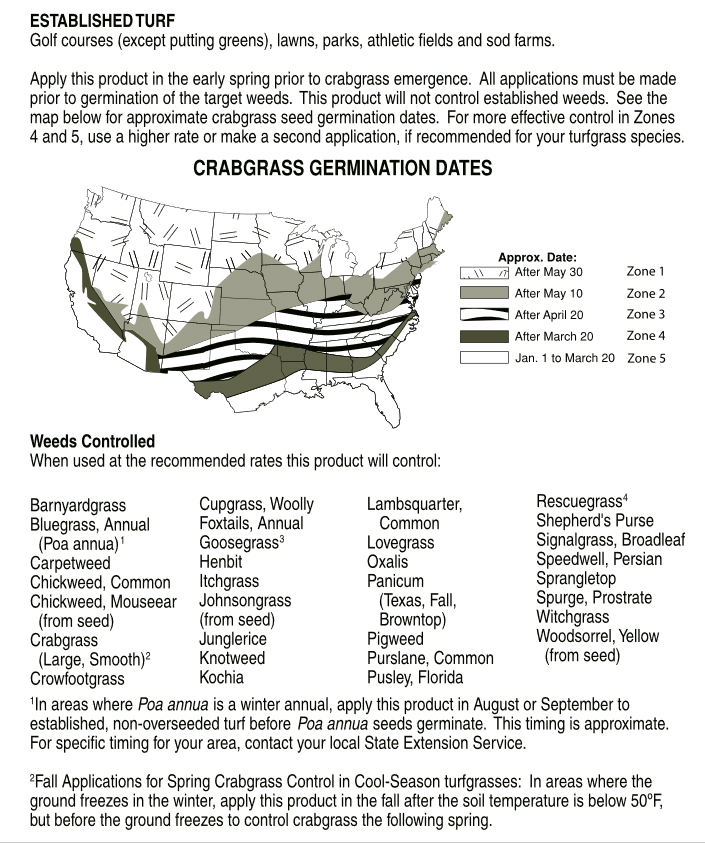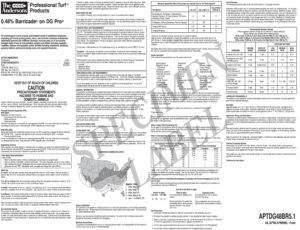The Best Lawn Pre-Emergent
This is the granular pre-emergent that Doc uses.
Apply with a lawn spreader and read the Bermuda lawn guide for EXACT instructions.
#1 – Target your WEED at the right time.
You apply a pre-emergent based on the weeds you want to PREVENT for the next 3-5 months. Example: There is no reason to worry about CRABGRASS in the late fall, going into winter, but you would want to target Poa Annua and other winter weeds / grasses. However, you WOULD want to make sure your preemergent stopped crabgrass when putting down in March or April. (based on your zone).
#2 – Many liquid pre-emergents cover a broad spectrum
Many products listed below will cover a broad spectrum of target weeds. So make sure you read the label and make sure your TARGET weed is covered. They often cover crabgrass even though you are not targeting it. (Such as fall and winter) But that’s OK… they’ll stop those darn winter weeds like chickweed and poa annua.
#3 – Vary using both light treatments of granular and spray for best results.
We have found the best results from applying at a LOW RATE of each listed on the label. You can space these out a few weeks in-between. Example… a low rate of granular early in the spring / late winter and then a LOW RATE of the liquid right on time a few weeks later. Generally you only need one treatment in the fall. By law… you have to follow the label which means you may be limited to “X” number of applications or maximum rates per year. Finding a BROAD SPECTRUM granular is not easy.
#4 – DO NOT OVER APPLY or APPLY TO NEW SOD
We try to write these instructions at an “8th grade reading level”… but some have suggested that we say OVER APPLY pre-emergents. That is NOT what we are saying. Apply ONE chemical in granular form lightly… then come back a few weeks later and apply a different spray chemical LIGHTLY. Example: Barricade DG then Dimension (shown below).
PRE-EMERGENTS stop seeds from developing and inhibit new root growth at a shallow level. (1-2″) The chemical stops cell division in the plant, either root or shoot, preventing it from reaching the soil surface and sunlight. New sod should never have pre-emergent applied. We suggest a FULL YEAR of growth before using light treatments on NEW SOD. Instead use a post emergent to control weeds and be patient.
#5 Do not apply if you plan to SEED your lawn.
Pre-emergents stop seeds from growing. You’ll generally have to wait 4 months before trying to seed your lawn.
For most people the target soil temp we want to watch for is 50 degrees.
You can view or download this label.
Dimension – (Dithiopyr 24%) Also available in Cheaper Pouches below.
← Click for pricing
Targeted Weeds:
Grasses: Barley, barnyardgrass, bluegrass (annual) (Poa annua), brome, crabgrass (large, smooth and southern), crowfootgrass, dallisgrass (seedling), foxtail (giant, green and yellow), goosegrass, kikuyugrass, Mary’s grass, Oats (wild), Ryegrass (annual and perennial), Sandbur, Smutgrass
Broadleaf Weeds: Bittercress, Carpetweed, Chickweed, Geranium (Carolina), Henbit, Knotweed (prostrate), Lespedeza (common), Marestail, Medic (black), Mulberry weed, Mustard, Oxalis (buttercup), Parsley-piert, Pigweed (redroot), Pineapplewood, Purslane (common), Rocket (London), Shepherdspurse, Speedwell (corn), Spurge (garden, prostrate, spotted), Woodsorrel (creeping, yellow)
For use on:
Commercial and Residential Lawns, Golf Course Fairways, Roughs and Tee Boxes, and Commercial Sod Farms
* For Cool and Warm Season grasses including Bermuda grass.

- B



